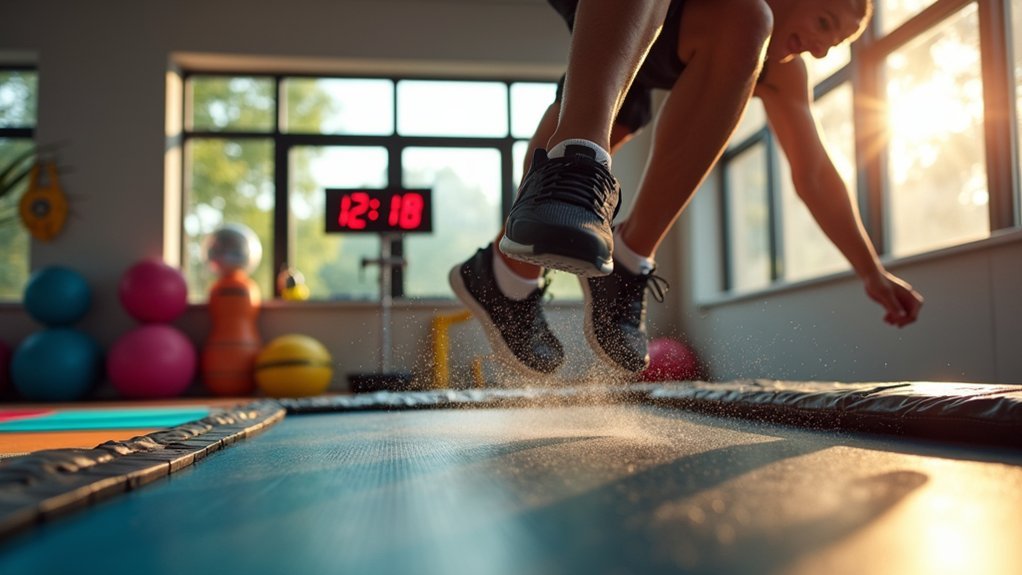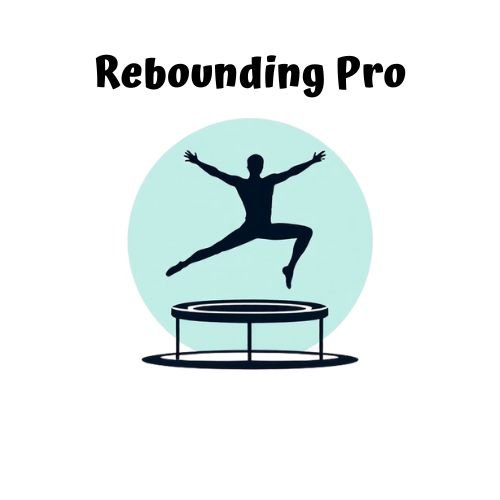Rebounding HIIT shreds fat effectively because it burns 20-30% more calories than traditional cardio while being gentle on your joints. The alternating g-forces amplify your metabolic rate and activate your lymphatic system, enhancing detoxification. You’ll experience EPOC (afterburn effect) for up to 24 hours post-workout, keeping your calorie burn elevated by 15-20%. The varied training stimuli prevent adaptation responses that cause weight loss plateaus. Discover how combining this with resistance training can transform your body composition completely.
Why Rebounding HIIT Shreds Fat Effectively

When it comes to efficient fat-burning workouts, rebounding HIIT stands in a league of its own. This powerful combination burns 20-30% more calories than traditional steady-state cardio, making it a superior choice for weight loss goals.
What makes rebounding HIIT particularly effective is its unique ability to engage multiple muscle groups simultaneously while being gentle on your joints. You’ll build muscle and burn fat concurrently, creating a more toned physique faster than conventional exercises.
The magic continues even after you’ve finished jumping. Your metabolic rate remains elevated post-workout due to the gravitational and acceleration forces experienced during rebounding.
This means you’re burning additional calories throughout your day—even while sitting at your desk or relaxing at home.
The Science Behind Rebounding’s Fat-Burning Power
The alternating g-forces experienced during rebounding HIIT workouts force your body to constantly adjust to gravity changes, markedly amplifying your metabolic rate beyond what’s possible with ground-based exercises.
Each bounce creates a “flush effect” in your lymphatic system, helping to remove metabolic waste and toxins that can otherwise impede efficient fat metabolism.
You’ll benefit from this unique combination of gravitational stress and improved circulation that conventional workouts simply can’t replicate, making rebounding particularly effective for stubborn fat loss.
Gravity Amplifies Metabolism
Three unique forces of physics transform rebounding into a metabolic powerhouse for fat loss. When you bounce, your body experiences acceleration, deceleration, and a moment of weightlessness—all of which intensify your workout’s metabolic impact. This gravitational dance creates a perfect storm for burning calories at an astonishing rate.
| Rebounding Physics | Metabolic Effect |
|---|---|
| Acceleration | Increases energy expenditure |
| Weightlessness | Maximizes muscle engagement |
| Deceleration | Boosts lymphatic circulation |
Your metabolic rate skyrockets during rebounding HIIT sessions, as your body works against changing gravitational forces. In just 12 minutes, you’ll burn the same calories as running a mile. The rhythmic bouncing stimulates your lymphatic system, eliminating toxins that could hamper metabolism and optimizing your body’s fat-burning potential.
Lymphatic Flush Effect
Beneath the surface of your rebounding workout lies a powerful detoxification system that amplifies fat loss: your lymphatic system.
Unlike your cardiovascular system, your lymphatic network lacks a pump, relying instead on physical movement to circulate effectively.
When you bounce on a rebounder, you’re creating the perfect environment for lymphatic flow—increasing circulation up to 15 times compared to sedentary activities.
This enhanced flow efficiently removes metabolic waste and toxins that would otherwise hinder your fat loss journey.
The rhythmic up-and-down motion supercharges oxygen delivery while simultaneously flushing out cellular debris.
This detoxification process optimizes your metabolism, creating ideal conditions for fat burning.
When combined with HIIT protocols, rebounding balances your hormones, further supporting a leaner body composition and maximizing your fat loss results.
How G-Force Amplifies Calorie Burn During Trampoline HIIT

When you bounce on a trampoline during high-intensity interval training, your body experiences a remarkable amplification of gravitational forces that can reach up to 4 times your body weight. This unique g-force maximizes calorie burn through constant acceleration and deceleration, engaging your entire muscular system more effectively than traditional workouts.
The efficiency is striking—just 10 minutes of rebounding burns equivalent calories to running a mile. Your body must work against this intensified gravitational pull with each bounce, activating multiple muscle groups simultaneously.
The low-impact nature allows you to maintain higher intensity levels for longer periods without injury risk.
The metabolic benefits continue long after your session ends, as trampoline HIIT triggers elevated post-exercise oxygen consumption, keeping your body burning calories for hours afterward.
Metabolic Acceleration: The Afterburn Effect of Rebounding
The calorie-burning benefits of rebounding HIIT extend far beyond the workout itself through what exercise physiologists call the “afterburn effect.”
The revolutionary afterburn effect transforms rebounding HIIT from a mere workout into a 24-hour metabolic catalyst.
This metabolic phenomenon—technically known as Excess Post-exercise Oxygen Consumption (EPOC)—transforms your body into a fat-burning machine for up to 24 hours after you’ve stepped off the trampoline.
When you perform rebounding HIIT, you’re not just burning calories during your session—you’re elevating your metabolic rate by 15-20% afterward.
Your body requires additional oxygen to restore itself to pre-exercise levels, consuming more energy in the process.
The intense rebounding movements followed by brief recovery periods optimize this afterburn effect, enhancing fat oxidation long after you’ve finished exercising.
Unlike steady-state cardio, rebounding engages multiple muscle groups simultaneously, further amplifying your calorie burn throughout the day.
Timing Your Intervals: Optimal HIIT Structures for Fat Loss

Structuring your rebounding HIIT intervals effectively can make the difference between moderate results and exceptional fat loss. The sweet spot for most rebounders lies in the 30:30 format—30 seconds of high-intensity interval training followed by 30 seconds of active recovery, which optimizes calorie burn while preserving muscle mass.
For maximum fat-burning benefits, schedule your rebounding sessions 2-3 times weekly, giving your body adequate recovery time while maintaining an elevated metabolism.
Try incorporating Tabata protocols (20 seconds work, 10 seconds rest) to intensify fat oxidation and boost cardiovascular fitness.
Remember to adapt your interval timing to your fitness level. As you progress, you’ll need to adjust intensity and duration based on your perceived exertion.
This personalized approach guarantees your rebounding HIIT routine continues to challenge your body and accelerate fat loss.
Full-Body Engagement: Why Trampoline Workouts Target More Muscles
Your trampoline HIIT workout activates muscles from all angles through multidirectional bouncing that traditional cardio simply can’t match.
Every rebound challenges your core stability as your body constantly works to maintain balance while moving through different planes of motion.
You’ll recruit more muscle fibers with less joint strain, allowing for more intense fat-burning sessions that simultaneously build functional strength.
Multidirectional Muscle Activation
Unlike traditional cardio workouts that often isolate specific muscle groups, rebounding on a mini-trampoline engages your entire body through multidirectional movements.
When you perform twists, jumps, and bounces, you’re activating stabilizing muscles that rarely get challenged during conventional exercises.
This full-body engagement creates a powerful fat-burning workout as you experience moments of weightlessness followed by controlled landings. Your body must constantly adjust to maintain balance, recruiting both fast-twitch and slow-twitch muscle fibers simultaneously.
The result? You’ll burn calories comparable to running a mile in just 12 minutes.
The beauty of rebounding HIIT lies in its efficiency—every bounce forces your muscles to work in multiple planes of motion, increasing overall muscle activation while shredding fat.
Your legs, core, and arms all work together, maximizing calorie burn in minimal time.
Core Stability Challenge
At the heart of rebounding’s effectiveness lies its unparalleled core stability challenge. Every bounce activates your deep abdominal muscles, creating a natural tension that strengthens your core while you’re focused on the HIIT intervals.
You’ll notice improved stability as your body constantly adjusts to maintain balance during weightless moments.
- Your core engages automatically with each bounce, firing stabilizing muscles often neglected in traditional workouts.
- The momentary weightlessness forces your body to recalibrate, enhancing muscle engagement by 25% compared to conventional exercises.
- Your entire muscular system works in concert, creating a true full-body workout experience.
- Smaller stabilizing muscles activate alongside major muscle groups, improving functional strength.
- The rhythmic nature of rebounding builds core stability while maximizing calorie burn through multi-muscle activation.
Lower-Impact Muscle Recruitment
While traditional high-intensity workouts often strain joints and ligaments, rebounding HIIT delivers powerful muscle activation without the punishing impact. You’ll engage multiple muscle groups simultaneously with each bounce as your body responds to the unique combination of gravity and acceleration.
What makes rebounding exceptional is how it maximizes muscle recruitment through low-impact movement. During moments of weightlessness, your muscles work to stabilize your body before landing, enhancing coordination and balance while strengthening your core, legs, and arms.
You’re burning calories efficiently too—12 minutes on a trampoline equals running a mile. This makes rebounding HIIT particularly effective for fat loss while building endurance.
The dynamic nature of these movements guarantees consistent muscle engagement throughout your entire workout, delivering thorough strength benefits without stressing your joints.
Lymphatic System Activation for Enhanced Detoxification
Because your lymphatic system lacks its own pump mechanism, rebounding HIIT provides the perfect solution for activating this critical detoxification pathway. Each time you bounce, you create a momentary weightlessness that opens and closes lymphatic vessels, effectively pumping toxins out of your body.
- Your lymphatic circulation improves with each bounce, reducing risk of lymphedema.
- Waste products flush more efficiently when you rebound regularly.
- Your immune function gets a boost from increased lymphocyte circulation.
- The rhythmic bouncing creates a natural detoxification effect throughout your entire system.
- You’ll experience enhanced overall health as your body clears cellular waste more effectively.
This unique activation of your lymphatic system through rebounding supports your body’s natural detoxification processes, making it an essential component of effective fat loss programs.
Low Impact, High Results: Joint-Friendly Fat Burning
If you’ve ever avoided high-intensity workouts due to joint pain or concerns about injury, rebounding HIIT offers the perfect solution. The mini-trampoline absorbs up to 87% of impact, allowing you to burn calories intensely without stressing your joints.
| Rebounding Benefit | Fat Loss Impact |
|---|---|
| Low impact design | Protects knees, ankles, hips |
| Calorie burn efficiency | 12 minutes equals 1 mile run |
| Elevated heart rate | Increases post-workout metabolism |
| Joint-friendly movement | Enables consistent training |
You’ll experience cardiovascular benefits comparable to running while enjoying considerably reduced stress on your body. This makes rebounding HIIT sustainable for long-term fat loss success, as you can maintain a regular exercise schedule without pain or recovery setbacks that typically accompany high-impact workouts.
Progressive Intensity: Scaling Your Rebounding HIIT Workouts
Once you’ve mastered the basic rebounding movements, scaling your HIIT workouts becomes essential for continued fat loss progress.
Progressive intensity guarantees you consistently challenge your body, maximizing calorie burn and preventing plateaus in your fat-shredding journey.
The secret to sustainable fat loss lies in never letting your body adapt—challenge is where transformation happens.
- Start by adding height to your jumps—even an extra inch increases workout intensity.
- Extend your high-intensity intervals from 20 to 30 seconds as your stamina improves.
- Incorporate compound movements like twist jumps that engage multiple muscle groups simultaneously.
- Reduce recovery periods gradually, from 30 to 15 seconds, to boost cardiovascular demand.
- Track your progress weekly, increasing intensity by 5-10% to maintain motivation.
This strategic approach to progressive intensity can boost your post-workout calorie burn by up to 30%, while the adjustable nature of rebounding HIIT guarantees you’ll always have room to grow.
The Hormonal Advantage: How Rebounding Regulates Fat-Storing Hormones
Your body’s hormonal balance plays a vital role in determining whether you store or burn fat, especially in troublesome areas like your abdomen.
Rebounding HIIT workouts naturally reduce cortisol levels through endorphin release, helping prevent stress-induced fat accumulation while simultaneously improving your insulin sensitivity.
This improved insulin response means your body becomes more efficient at processing carbohydrates for energy rather than storing them as fat, creating a powerful two-pronged hormonal advantage for sustainable weight management.
Cortisol Balance Benefits
While many exercise programs focus solely on calorie burn, rebounding HIIT offers a powerful hormonal advantage through its unique ability to regulate cortisol. Your body’s response to this low-impact, high-intensity workout creates a favorable environment for weight loss by preventing the cortisol spikes that typically promote abdominal fat storage.
- You’ll experience improved insulin sensitivity as your cortisol levels normalize, making blood sugar management more efficient.
- Your fat metabolism increases when cortisol production decreases during consistent rebounding sessions.
- You benefit from endorphin release during rebounding, naturally counteracting stress hormones.
- Your metabolic health improves as hormonal balance is restored through rhythmic bouncing movements.
- You’ll notice reduced stubborn belly fat over time as your body’s stress response systems recalibrate.
Insulin Sensitivity Boost
Beyond just burning calories, rebounding HIIT transforms your body’s relationship with insulin, creating a metabolic environment primed for fat loss.
When you perform these bouncing intervals, you’re enhancing insulin sensitivity by up to 24% in as little as two weeks of consistent training.
This improved sensitivity means your body utilizes glucose more efficiently, dramatically reducing fat storage potential.
Your rebounding sessions create a dual impact through both aerobic and anaerobic elements, stimulating insulin-regulating hormones that favor weight loss.
For those concerned about diabetes risk, you’ll appreciate how rebounding HIIT improves blood sugar control while simultaneously lowering elevated insulin levels.
The result? A body that’s metabolically optimized to shed stubborn fat while improving overall hormonal health—making your HIIT training sessions on the rebounder far more effective than traditional cardio alone.
Combining Strength Elements With Rebounding for Maximum Results
Although rebounding alone offers impressive cardiovascular benefits, integrating strength elements into your routine dramatically amplifies your results. When you combine resistance bands or dumbbells with your rebounding workouts, you’ll experience a 25% greater muscle improvement over just 12 weeks.
- Perform low-impact squats and lunges on your rebounder to minimize joint strain while maximizing calorie burn.
- Alternate between strength training and bouncing to build endurance and improve body composition.
- Add push-ups against the rebounder frame to engage multiple muscle groups simultaneously.
- Incorporate HIIT workout principles to keep your heart rate elevated, increasing post-exercise calorie burn.
- Use resistance equipment during rebounds to simultaneously tone muscles and boost cardiovascular performance.
This combination creates a thorough approach that enhances fat loss, muscle development, and overall fitness—all while keeping your workouts engaging and motivating.
Breaking Through Weight Loss Plateaus With Trampoline Intervals
Your body adapts to predictable workout routines, causing weight loss to stall when you’ve been doing the same rebounding exercises for weeks.
Trampoline HIIT intervals shock your metabolic system by introducing unpredictable intensity variations that prevent this adaptation response.
Shock Metabolic System
When weight loss progress stalls, trampoline-based HIIT can effectively shock your metabolic system back into action. Your body quickly adapts to routine exercises, but rebounding HIIT introduces unpredictable intensity that forces your metabolism to respond dramatically.
This metabolic shock is precisely what you need to burn fat efficiently.
- HIIT burns 30% more calories than steady-state cardio in the same timeframe
- Alternating between 85-95% maximum heart rate and recovery periods maximizes fat-burning potential
- Your body continues burning calories for hours after your workout through EPOC
- The low-impact nature of rebounding lets you push harder without joint stress
- These intense intervals create the metabolic disruption needed to overcome stubborn weight loss plateaus
With consistent rebounding HIIT sessions, you’ll breakthrough plateaus while protecting your joints from high-impact stress.
Prevent Adaptation Response
The human body constantly seeks homeostasis, making adaptation to exercise routines inevitable and often leading to frustrating weight loss plateaus.
Rebounding HIIT disrupts this natural tendency by introducing unpredictable training stimuli your metabolism can’t easily adjust to.
When you bounce between high-intensity jumps and recovery periods on a trampoline, you create varied gravitational forces that continuously challenge your muscles in unique ways.
This systematic variation prevents your body from settling into an efficient metabolic state that conserves energy and stalls weight loss.
Research shows this approach burns up to 30% more calories than steady-state cardio, while the elevated post-exercise oxygen consumption keeps your metabolism fired up for hours afterward.
Tracking Progress: Measuring Fat Loss Beyond the Scale
Obsessing over the number on your bathroom scale might actually derail your fat loss journey, since weight alone doesn’t tell the full story of your body’s transformation.
When tracking progress with rebounding HIIT, focus on thorough body composition changes rather than simple weight loss metrics.
- Measure body circumference at your waist, hips, and thighs to detect fat reduction even when the scale remains stubborn.
- Use skinfold calipers to assess body fat percentage changes more accurately than weight alone.
- Take progress photos consistently to visually document shifts in muscle tone and fat distribution.
- Keep a fitness journal tracking workouts, diet, and energy levels to identify effective patterns.
- Invest in a body composition scale that distinguishes between fat mass and muscle mass for a complete picture.
Creating a Sustainable Rebounding HIIT Routine for Long-Term Success
Beyond monitoring your progress lies the practical challenge of building a rebounding HIIT practice you’ll actually maintain long-term. Start with just 1-2 rebounding sessions weekly, keeping them short at 20-30 minutes to prevent burnout while maximizing fat-burning potential.
Your exercise routine should feature diverse movements—high knees, jumping jacks, and twists—to engage different muscles and keep workouts fresh. As your fitness improves, gradually increase high-intensity intervals from 30 seconds to up to a minute.
For meaningful weight loss, pair your trampoline workouts with balanced nutrition that fuels recovery and enhances metabolic function. Set specific, measurable goals and track them consistently, providing the accountability needed to stick with your routine when motivation wanes.
This balanced approach guarantees you’ll create sustainable results rather than short-term fixes.
Frequently Asked Questions
Does Rebounding Help Lose Fat?
Yes, rebounding helps you lose fat efficiently. You’ll burn calories quickly, boost your metabolism, and engage multiple muscles. It’s low impact, improves insulin sensitivity, and works especially well in HIIT formats for maximum fat-burning results.
What HIIT Exercise Burns the Most Fat?
Sprinting intervals burn the most fat in HIIT workouts. You’ll maximize calorie burn with all-out efforts followed by brief recovery periods. Burpees, jump squats, and mountain climbers are also extremely effective fat-torching exercises.
What Is 10 Minutes on a Rebounder Equivalent To?
Ten minutes on a rebounder equals running a mile in calorie burn (about 50 calories). You’ll engage multiple muscle groups and continue burning calories after your workout due to the increased metabolic rate.
Why Does HIIT Training Burn Fat?
HIIT burns fat effectively because you’re alternating high-intensity bursts with recovery periods. This elevates your metabolism, creates an EPOC effect, and improves insulin sensitivity—all helping you burn calories during and after your workout.
In Summary
You’ve discovered a powerhouse workout with rebounding HIIT. By embracing the G-force advantage, metabolic acceleration, and structured intervals, you’re maximizing fat loss potential with every bounce. Don’t forget to track progress beyond weight and incorporate strength elements to break plateaus. Keep your routine sustainable, and you’ll continue shredding fat long after the trampoline stops bouncing.





Leave a Reply